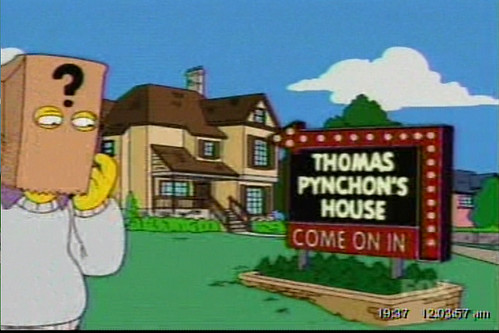The Danish documentary Thomas Pynchon: Journey into the Mind of P. inadvertently demonstrates the problematics involved with anonymity in literature. Part of the problem is simply that the two filmmakers, Donatello & Fosco Dubini, have about 45 minutes of actual information, but have determined to pad it out to a full-length feature 90. But the real problem is that they have no there here. The film, the closest I suspect Pynchon will ever get to his own E! True
What we get instead is a tour of some elements of the Thomas Pynchon industry – not the academic one, composed as it is of people who’ve read his works – the closest they get is a short talking-head spot with the late George Plimpton reminiscing about a review he wrote of V. – but the over-the-top fans who have their own fansites on the web & speculate – at length – that since Pynchon & Lee Harvey Oswald were in Mexico at roughly the same time in the 1950s, therefore Pynchon must be in hiding because of what he knows about the assassination of JFK. This is accompanied with much stock footage of Lee Harvey Oswald passing out “Hands Off Cuba” leaflets in New Orleans & Jack Ruby gunning Oswald down on
The
The remainder of the film is devoted to people who think they have seen Thomas Pynchon, including an Aussie journalist who staked out an uptown Manhattan residence (whose address he had gotten by tracing details in public records related to the death of Pynchon's parents) until he decided that a certain 60ish male walking down the street with an eight-year-old son was Pynchon & snapped a photograph that, even blown up, is little more than generic pixels. CNN did likewise once and then decided to simply do a story on Pynchon’s reclusiveness while showing many people walking down the streets of Manhattan before telling the audience that one of the people they had just seen was Pynchon, without identifying which one. The film ends with Siegel & the filmmakers focusing in on one guy in a Kansas City Royals baseball cap whom they say CNN told them was Pynchon (Siegel doesn’t believe it, preferring instead a guy who looks a lot like poet Geoffrey Young).
In fact, Pynchon’s only public appearance ever has been on the Simpsons, where you do get to hear his voice & see the portrait above. Does this mean that his skin is really yellow or that he only has four fingers on each hand?
I never have asked the poet Allen Fisher, who published some of Pynchon’s essays in chapbook form, how he got in touch with the elusive author, tho I did once ask Mimi Fariña – whom I knew somewhat during the early 1970s – what Pynchon was doing then (he had been the best man at her wedding, her husband having also been part of the Cornell writing scene in the 1950s). This was during the silent period between
My point is that it didn’t really matter then & it doesn’t now, but minutiae like this have been turned by Pynchon himself into part of a great puzzle that, I think, detracts from what actually is valuable in the man’s writing. As I noted yesterday, context is one of the six functions of language &, if you make a point of hiding a part of the context, you can pretty well count on readers foregrounding exactly that one element. Do we really need to know about J.D. Salinger’s bouts with Scientology, Hinduism or that he drinks his own urine? It’s Salinger who has made these tidbits a part of his fiction, precisely by making his actual life a mystery. Pynchon has made the same mistake.
Robert Duncan once told me that his own 15-year hiatus from publishing books post-Bending the Bow had been an accident. He had said it half in jest to New Directions publisher James Laughlin simply because Robert didn’t have the work ready in what Laughlin – who had been expecting maybe one big book every three years,
Thomas Pynchon has a new novel, Against the Day, forthcoming this November. You can even read a passage by clicking that link. At 1060 pages from a novelist who is now 69, it may well be the last big book we ever get from Pynchon, and it’s only his sixth one. It would nice to imagine that people will read it for what it is, and not as a cryptogram for deciphering what the author doesn’t care to share.
¹ The only other film relating to Pynchon would appear to be a German adaptation of Gravity’s Rainbow entitled Prüfstand VII that appears never to have had American distribution.






